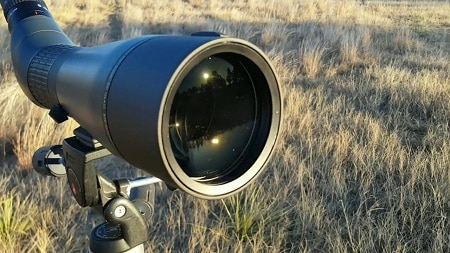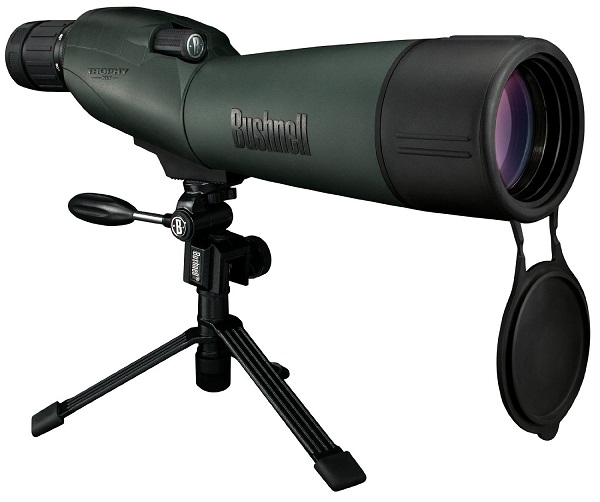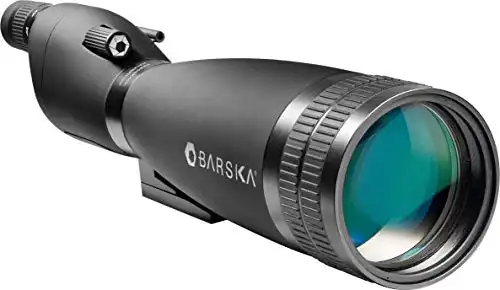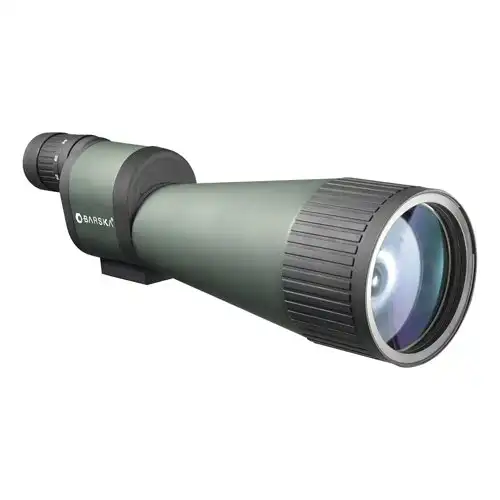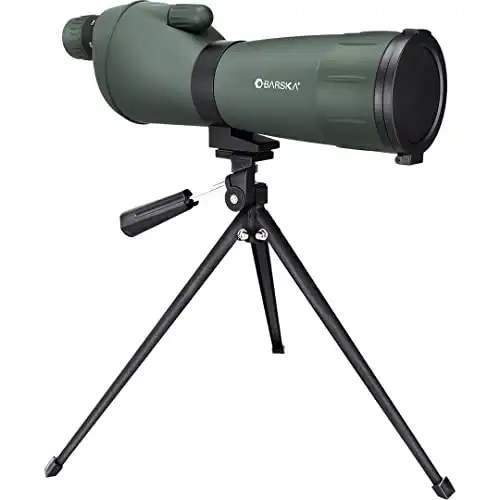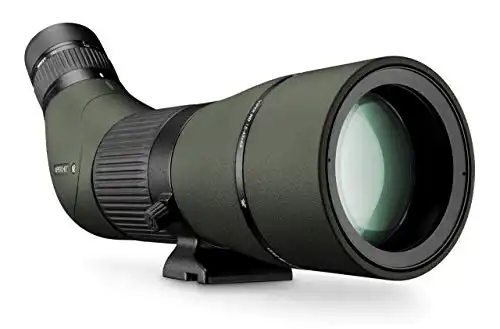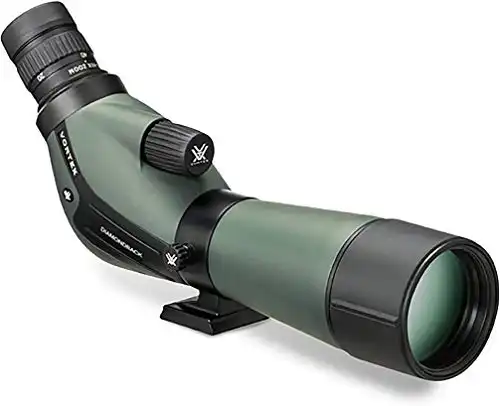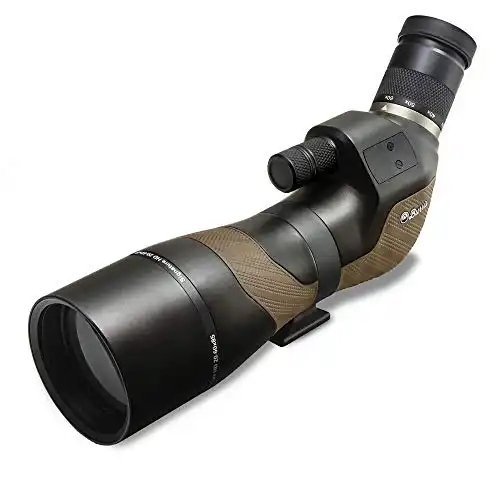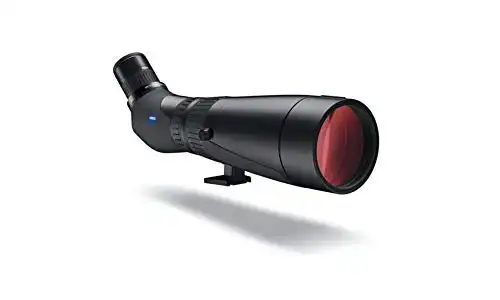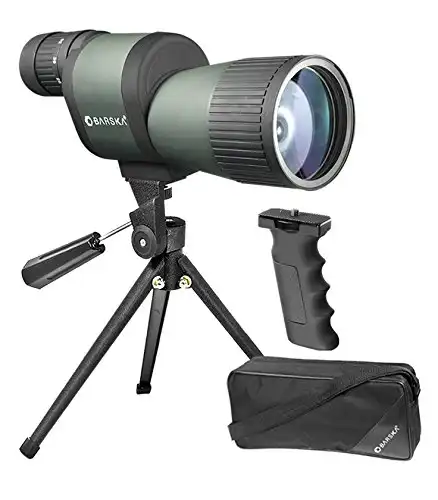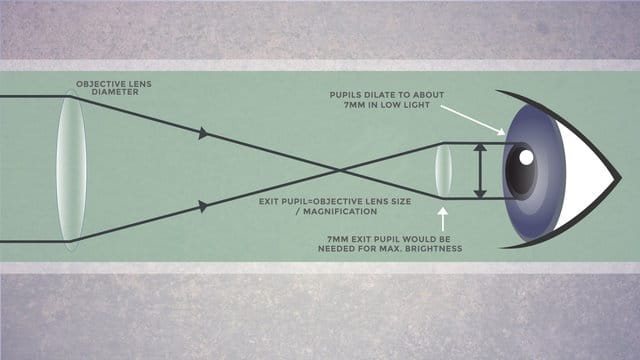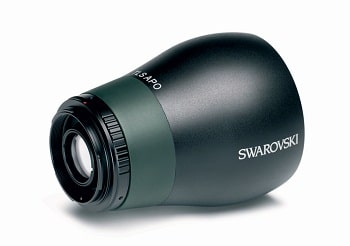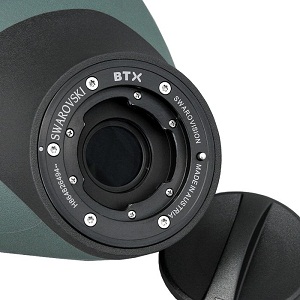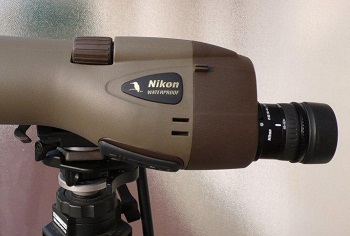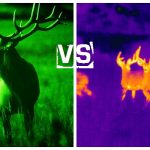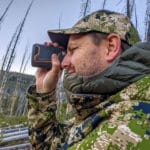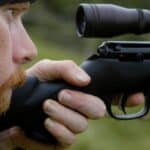If you are into birdwatching and other naturalist activities, hunting, and shooting, a spotting scope is something that you may need and want to spice up your hobby with.
Unlike the usual telescopes and binoculars, it has added optics to give you a sharper focus and wider view.
So how do you choose the spotter scope that suits your activity? This article will help you by:
- reviewing the best spotting scopes for different activites
- giving a overview of important spotting scope specifications and features you should be aware of
- listing the best spotting scope brands on the market today
The 10 Top Spotting Scopes of 2021: Outdoor Empire Reviews
These are our top recommendations for spotting scopes of 2021:
- Best for the money #1: Bushnell Trophy XLT
- Best for the money #2: Barska Gladiator
- Best budget #1: Barska Benchmark
- Best budget #2: Barska Colorado
- Best for hunting #1: Vortex Viper
- Best for hunting #2: Vortex Diamondback
- Best for target shooting: Burris Signature HD
- Best for birding: Zeiss Victory Harpia
- Best under 500: Bushnell Legend
- Best compact: Barska Benchmark 8-24×58
*Looking for a specific feature? Check out our quick-reference chart below:
| Category | Best for hunting | Best for the money | Best budget |
|---|---|---|---|
| Product | 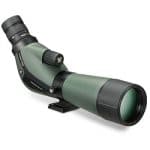 | 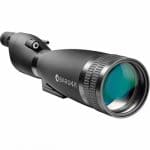 | 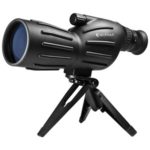 |
| Magnification | 20-60x | 20-60x | 20-60x |
| Objective Lens Diameter | 60 mm | 90 mm | 60 mm |
| Close Focus | 20 ft | 32.8 ft | 26 ft |
| Exit Pupil | 3-1 mm | 5.1 mm @ 20x 1.7 mm @ 60x | 3-1 mm |
| Eye Relief | 14-17 mm | 21.6 mm @ 20x 18.7 mm @ 60x | 14.5-11.2 mm |
| Weight | 33.8 oz | 48 oz | 30 oz |
| Length | 14 in | 16.7 in | 13.5 in |
| Cost | Check Price | Check Price | Check Price |
1. Best Spotting Scope for the Money: Bushnell Trophy XLT
If your goal is to combine cost-effectiveness and gear functionality, then the Bushnell Trophy XLT is what you’re looking for.
Pros
- You get a variable magnification of 20 to 60 power with a 65mm objective lens. This gives you a wide range of magnification and a decent field of view.
- The picture you get is clear and very bright.
- Seeing large objects at extended ranges is easy.
- Built to be tough and rugged which makes it a good choice for birding or hunting.
- The glass is fully multi-coated and it gives solid clarity.
Cons
It is not going to give you the performance that you may need to spot holes in a target at 500 yards. For nature observation, scouting areas, and range performance of up to 200 yards, this bad boy works.
Conclusion
It is water and shockproof, plus you get a complete kit, which is a significant advantage for those who want to save money without compromising effectiveness. The kit includes a tripod, a hard side carrying case, and a soft case.
Out of the box, it is ready to go and nothing else is needed.
Read the full Bushnell Trophy XLT review…
2. Best Spotting Scope for the Money #2
If you call your optic the Gladiator, you’d better make it tough! In general, scopes are somewhat fragile. Anytime you add glass to a device used outdoors you, can bet you’re going to get a somewhat weak item.
Not so with the Barska Gladiator. Instead, it is a rough and ready optic! This spotting scope is o-ring sealed and nitrogen purged. These features work to resist fogging, clouding, and moisture damage while you are out in the field.
This scope is coated with a rubberized shock-absorbing armor that gives it a very grippy outside and a tough inside. The Gladiator even comes with a sturdy, multi-adjustable tripod that has a quick release platform. The optics are fully multi-coated and the 100mm objective lens is massive. The combination of these two features results in a clear and bright sight picture.
Let’s not forget that the magnification level is 20-60x! That’s very high level and at this price almost unheard of. Unfortunately, the spotting scope is on the heavy side. Fortunately, it comes with a convenient carrying case to help ease the load. For extreme performance in extreme environments, look no further than the Barska Gladiator.
3. Best Budget Spotting Scope
If budget is the main issue in finding a spotting scope, you need to compromise on a lot of features and just focus on your overall need.
A budget scope is never a Jack of all trades. Typically they are capable of doing only one or two things well and being subpar with other tasks. That’s just the honest truth of the matter.
The Barska Benchmark is a compromise. The good news is, it provides you a massive amount of magnification and a large objective lens.
Conclusion
The Barska Benchmark is perfect for observing nature, scouting the land, and even hunting. For long range target shooting, it lacks the clarity necessary to see hits on targets.
You are setting yourself up with a solid spotting scope that delivers a wide field of view and puts you face to face with nature.
4. Best Budget Spotting Scope #2
Barska is a leading name in the budget market. They produce affordable and high-quality optics that often function well beyond their price range. Introducing the Colorado. The Colorado is a rugged spotting scope designed for a wide variety of tasks. It excels in nature watching, hunting, and even digiscoping.
The Barska Colorado features a 60mm objective lens so it is not the most compact of optics. However, it has a variable magnification of 20 to 60 power. Not to mention the incredibly quick access focus. This allows you to stay on the picture with clarity while cycling through the magnifications.
The Colorado is fully waterproof, a feature you rarely see on optics in this price range. It’s certainly a welcome feature, especially for those that don’t mind the rain. The optic is built for the outdoors and does wear a rubber armoring for external protection. It’s also nitrogen purged for fog proof performance.
The Colorado spotting scope features a straight lens, and many find this comfortable for viewing items on the same plane. It even comes with a tripod. Again, this is impressive for an optic at the Colorado’s price range! The scope is large, but it only weighs 2.8 pounds. This makes it easy to carry on long adventures through the brush.
5. Best Spotting Scope For Hunting
- Smaller and lighter than other Vortex models. It fits in a pack so it’s easier to haul through the wilderness.
- It is their mid-tier optic and delivers extremely clear and consistent picture. You can count the antlers on a deer at extended ranges with ease during the day.
- Picatinny rail built on the system which allows the user to mount an accessory if needed.
- You can choose between an angled view lens and a straight lens. Angled gives the user a comfortable and suitable method of scanning in different sitting positions.
- I prefer a straight eyepiece that allows a hunter to track an animal easier and is trouble-free to use from a tree stand.
- The biggest downside is its heaviness. Depending on where you hunt you may want to keep weight as low as possible.
As a hunter, you have special considerations for all your gear. It needs to be rugged, capable and prepared to explore the great outdoors. The Vortex Viper is certainly well built for the hunter. It comes in a wide variety of magnification ranges.
For hunters, I’d suggest the 15 to 45 power model.
Conclusion
The Vortex Viper is a well-made optic that can take the rough nature of hunting with ease. It is element-proof, shockproof, and can resist water and fog. Nature doesn’t have anything on the Vortex Viper.
Included is a carrying case that is custom fitted to the spotting scope as well as an eyepiece cap and lens cover.
Read the full Vortex Viper review…
6. Best Spotting Scope for Hunting #2
- XR fully multi-coated lenses for a brilliantly clear picture
- Lightweight package
- 20-60x magnification rating
- Waterproof
- Shockproof
- Argon purged
- Expensive
Hunting can be a rough sport, and some environments are rougher than others. With that in mind, we chose an optic we think would be good in any hunting environment. Overall, the Vortex Optics Diamondback performed best in the harshest and most demanding environments.
The Diamondback is a no-nonsense spotting scope that comes in a wide variety of configurations. My personal choice would be the 20-60×60 model. This offers you substantial magnification as well as a lighter package.
When hunting in harsh environments, you want to trim weight where you can. The Diamondback sports XR fully multi-coated lenses that produce a picture to die for. This coating along with the high-quality glass gives you a lifelike picture no matter what’s in front of you!
Most animals have a somewhat natural camouflage. For example, a brown deer in the fall looks a lot like the brown leaves around him when the light is low. With the clear picture the Diamondback provides, you’ll be able to see the difference between a deer and a leaf in an instant!
This Vortex spotting scope is made from quality materials with quality manufacturing. It will shrug off water and resist shock. It can take a serious beating and come out unscathed. It’s the optic you need no matter what conditions your hunt throws at you.
7. Best Spotting Scope for Target Shooting
- Clear, accurate images
- Wide magnification range
- Water and internal fogging resistance
- Compatiblity with other Burris accessories, like the Fastfire Red-Dot Sight
- Dual-speed focuser
- Expensive
- Must be adjusted for comfort based on position (sitting, standing, lying down, etc.)
The Burris Signature HD Spotting Scope is a beautifully crafted scope for target shooting. Its apochromatic lens system and index-matched broadband lens coatings work together to give the user bright and clear high-contrast images.
The images produced have extremely accurate color and minimal distortion across the entire field of view. The range of magnification is perfect for medium to long distances, and the field of view is wide enough for focusing on both large and small objects.
The tube is argon filled and O-ring sealed, providing resistance to water and fogging while in the field.
Users describe the Burris Signature HD Spotting Scope as “head and shoulders above their competition.” Compared to other scopes in this price range, the Burris is the highest quality. This scope is the perfect fit for anyone needing to clearly locate a target.
8. Best Bird Spotting Scope
- Three-stage wide-angle zoom
- Rapid and automatic switching between coarse and fine focus
- Water and fog resistance
- Clear, consistent images
- Vario eyepiece not included
- Expensive
- Large to carry around
- Does not attach to a camera
The Zeiss Victory Harpia Spotting Scope provides beautiful and clear images, no matter the strength of magnification. The optical system on this scope is new and one of a kind because of its three-stage wide-angle zoom, which provides a constant field of view.
This scope also has a combination of up to 70x magnification with 95-millimeter objective lenses, allowing the user to hone in on the smallest of details. Zeiss DualSpeed focus gives you exact, quick focusing at all times.
The Zeiss Victory Harpia Spotting Scope is nitrogen-filled for resistance against water and fog, and can attach to a tripod for stationary use.
This listing is for the main body of the scope without the Vario eyepiece, which is required for proper use.
Although expensive, users stress that the Zeiss Victory Harpia Spotting Scope is an investment they treasure. This scope allows for crystal-clear bird viewing from a multitude of distances. It is the perfect purchase for the avid bird watcher looking for a lifelong accessory.
9. Best Spotting Scope Under 500: Bushnell Legend
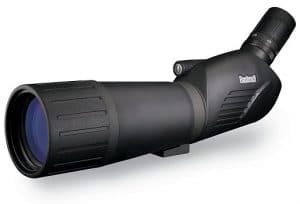
This is a straight optic, but an angled version exists. However, the straight version is our personal preference. The Bushnell Legend offers a wide variety of features you’d normally find in more expensive optics. Let’s start on the outside and work our way in.
Pros
- 20 to 60x magnification with a very clear picture.
- Rainguard lenses – great for all weather use
- Bak-4 prism and multi-coated lenses for a bright and vivid picture
- Tough and reliable
Cons
- Users may experience mirages on bright days
The Legend is outfitted with a strong polymer housing and reinforced in its most vital zones. You’ll see the reinforcement around the lenses and the adjustment knobs. These areas are also textured for an easy grip. The Legend has a solid throw lever that’s easy to manipulate and utilize. Not to mention the optic’s focus ring is strong and durable!
The Bushnell Legend packs a 20-60-power level with a 60mm objective lens. That kind of magnification makes this optic an absolute powerhouse! Additionally, it comes fully equipped with multi-coated optics and Bushnell’s Rainguard lenses.
This spotting scope uses a premium quality BAK-4 prism. When you combine that with the coated lenses you get a clear picture. The Bushnell Legend is also water and shockproof, so you don’t have to worry about hurting your investment.
10. Best Compact Spotting Scope
Bigger is not always better. Sometimes you need smaller and lighter. If that’s your case, the Barska Benchmark is for you. It’s bigger and more potent than a monocular, yet smaller than most spotting scopes.
In fact, the Barska Benchmark 8-24×58 is a stout little guy. The objective lens makes it look stubby and a little fat for its size. However, at 58mm, you aren’t giving up much on the light-absorbing front. Besides, the Benchmark rocks fully coated lenses for a clear and bright picture.
The 8 to 48-power magnification is a little lower than most, but it’s still considerable in terms of power. Even at the lowest magnification setting, the field of view is an impressive 225 feet at 1,000 feet. The low 8-power magnification and wide 58mm objective lens give you a wide field of view. It’s perfect for tracking moving subjects.
The Barska weighs only 1.54 pounds so it’s easy to carry through the field. This little optic comes complete with a tripod and carrying case that all packs together rather nicely. The Benchmark is priced respectably and is perfect for those days where ounces equal pounds and pounds equal pain!
Take A Closer Look
When choosing a spotting scope for whatever reason, you need to examine both the internal and external parts of the optic. Have a firm understanding of how it works, including the meaning of different terms and features that go with it.
These features also have an effect on cost, clarity, and of course weight.
Eyepiece
Angled vs Straight
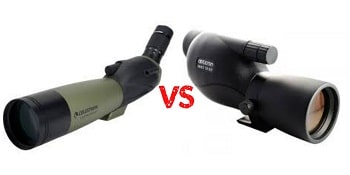
The angle of your eyepiece isn’t that important and is mainly a personal preference. A straight eyepiece is often better for the prone position and hunters in general. You can scan easily and track a target more naturally with it, and it’s easier to scan areas below you.
You can also mount a spotting scope to a truck or car mount and use it with ease if it’s a straight spotting scope.
Angled scopes offer a major role when it comes to digiscoping. Attaching a camera to a straight lens can be difficult and often throw the entire balance off on a tripod. It is more comfortable for extended viewing and makes birding a lot simpler especially if the birds are up in the sky.
Taller people usually prefer angled scopes for shooting for comfort reasons. Angled scopes are better for looking up and straight spotting scopes for looking down. Both look at ground level perfectly fine.
Internals
The eyepiece on any spotting scope is a critical consideration that a buyer should look into. Your eyepiece is going to determine your:
- eye relief
- magnification level
- digiscoping ability
- the way you view the world through the scope
Variable VS Fixed
The majority of eyepieces are variable. Meaning the magnification can change with the spin of a dial.
A fixed eyepiece has a system that operates on one magnification setting. A variable is more versatile, but a fixed is often simpler, more durable, and cheaper.
Wide Angle
Some eyepieces are designed to give a wide angle view, and others are designed for a traditional round view. Wide angle is more comfortable for extended viewing and allows the user to capture their environment with equal magnification.
Eyepieces also offer different lengths of eye relief. Folks with glasses are better suited with a long eye relief eyepiece.
Interchangeable
Some spotting scopes come with interchangeable eyepieces as well. This allows you to change the:
- eye relief
- interior angle
- different degrees
Most models designed for waterproofing do not have interchangeable eyepieces since they expose the internals of the system.
Objective Lens Size
The larger the objective lens is, the greater detail you can see and the exit pupil is higher as well. This applies to an optic with high magnification ratings. The higher magnification, the larger objective lens is needed to make a clear picture.
Size is important, but lens quality is more essential. A quality lens go further than a large one any day, consider looking for ratings like:
- HD glass
- ED glass
- APO glass
A large objective lens made of quality glass is the route to take for higher magnifications. This is critical for shooters who are attempting to find small holes in big targets.
Objective lens size is measured in millimeters and often come after the magnification when describing the spotting scope. For example, 25-60x80mm says that the optic is a variable optic with an 80mm objective lens.
Correlation
Objective lens, magnification, and exit pupil are all linked together.
Exit pupil is the size of the light beam exiting the lens. The perfect size will match the size of the user’s eye pupil. The closer the exit pupil is to the eye pupil size, the better the scope works for the user.
Exit pupil is found by dividing the objective lens size by its magnification. As the magnification increases, the exit pupil will shrink. The clearest picture will have the exit pupil matching your eye’s pupil size.
Eye pupils change size depending on the amount of ambient light.
- In normal and bright conditions the human eye pupil is 2 to 3mm.
- In low light conditions, your pupil is roughly 7mm.
So an exit pupil closer to 7mm means the spotting scope works better in low light.
Field of View
Field of view, or FOV, is the amount of an area you can see at a particular magnification. It is measured typically at a thousand yards. As magnification increases or range decreases, the field of view shrinks.
The field of view for a spotting scope is mainly tied to the eyepiece. Some are designed to focus more on the center of the optic and others are focused on capturing a wide angle view. Those with long eye relief have a shorter field of view.
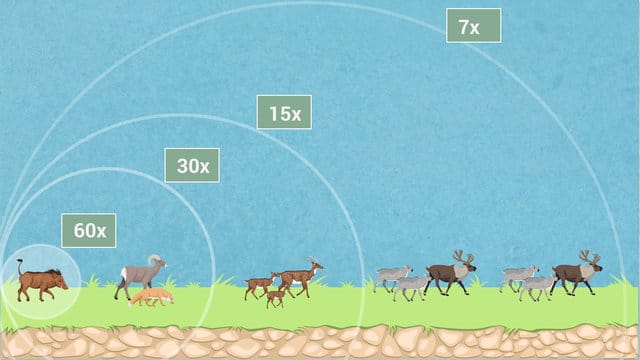
Other Important Factors to Consider
Once you grasp the important considerations, you also need to understand the outward effects that a spotting scope may have.
These external features are crucial when you are attempting to pair a spotting optic with a particular method of use. Meaning, birders have different needs than hunters.
These requirements change between users and are more subjective.
BaK5 or BK-7 Prism
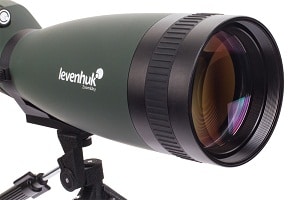
When searching for spotting scopes, you may run across a prism type, and the most common are the BaK5 prism or a BK-7 prism.
The lens corrects your image. Without it, the image would be upside down.
The BaK5 prism is the superior choice and provides a clearer picture, but also increases the cost of the optic. However, the clarity difference may not be noticed by owners using their scopes at 100 yards and less.
Close Focus
Close focus is the distance that the optic is capable of focusing at close range. On average, a spotting scope can focus as close as 20 feet. Anything closer than 20 feet is blurred and unfocused.
Some specialized spotting scopes are designed to focus closer distances, and this may be a requirement for you to consider.
You might also want to check this article on how far you can expect to see with your spotting scope.
Focusing Type
Spotting scopes have three different types of focus adjustment devices, and each offers its advantages.
Helical
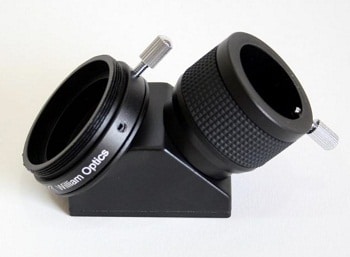
A helical focus is the most common, and it involves a collar around the scope. This collar is rotated in different directions to change the optic’s focus. It is quite easy and intuitive since it allows the user to change focus quickly and decisively.
This makes moving targets easy to focus on — perfect for birders and hunters.
Knob
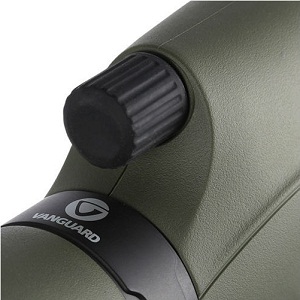
Knob focus involves a turret that is rotated in different directions to change focus. It is more precise than the helical, but also slower. It is the preferred focus for taking photographs and observing stationary targets.
Rack and Pinion
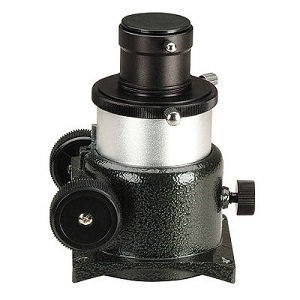
Lastly, there are rack and pinion designs. These are the most common scopes designed to look at the stars. They are fast and smooth, easy to operate and precise. However, they tend to be weak and open failure points when used outdoors.
How Rugged?
If you are planning to use your spotting optic for rough outdoor activities, a more robust design is ideal. Activities like hunting expose the scope to a rugged environment, whereas birding or nature observation is less stressful on the unit.
A rugged unit may use a rubber armor coating or thicker and strong aluminum design. This adds weight to the system but protects the fragile internal of a spotting scope. Rugged scopes are most likely waterproof.
A standard or nonrugged unit is lighter and usually more affordable as well.
Tripod
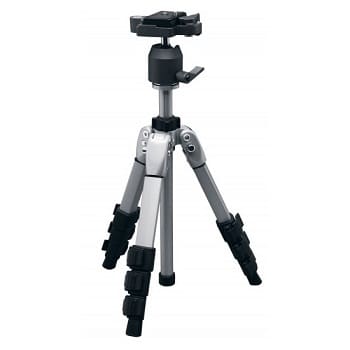
A tripod is essential to use a spotting scope effectively. If you are on a budget, it is suggested to get a scope that comes with a tripod since not all of the brands or models has one initially. You may also need to replace the tripod to fit your ideal use of the scope.
Some tripods allow the user to stand to use the scope. Others are designed to work from the prone of bench rest sitting position. Before you purchase a tripod, determine the position that the spotting scope is in. It’s important to choose the right size of the tripod, or you may find using the scope very uncomfortable.
Also, a cheap tripod and a heavy spotting scope can create shifting and be shaking which can be frustrating. If you invest in a quality scope do yourself a favor and invest in a quality tripod.
LeAding Spotting Scope Brands
Swarovski
Swarovski manufactures excellent optics, and the company prides themselves on producing high-quality spotting scopes. These scopes are often modular and provide the user with different options for scoping nature out.
Their ATX / STX spotting scopes can be swapped between an angled and straight lens at home. They also provide first rate support for digiscoping and make a variety of mounts to allow you to turn it into a camera lens.
Swarovski optics is genuinely well made, and some models provide fields of view of over a hundred feet wide. Their lenses and glass are some of the best in the world and give the user a very clear picture, even in the early morning and early evening.
Pros
If you are planning to use a spotting scope in low light conditions, this is the perfect model. They call this SwaroVision technology which provides the maximum color fidelity and clarity on the current market.
Their units are light as well, which makes them ideal for extended hikes.
Cons
The biggest downside is its price. You are getting the highest quality out there, but you’re also paying a hefty price for it. Another is the short eye relief associated with Swarovski optics doesn’t leave you much room to play around with. This can create uncomfortable positions if your tripod or base isn’t just high enough.
Vortex

Vortex is an American company that has been producing optics for quite some time. The name Vortex is new due to a rebranding of the enterprise. However, their quality hasn’t dipped in the slightest.
The spotting scopes they produce come in three distinct tiers. The Diamondback, the Viper, and the Razor. Each one of these optics comes at a different price level and offers different features and levels of quality.
At their base level, each Vortex optic is well made and protected. They are designed for heavy outdoor use and are sealed against water, dust, and debris. As a hunter, I’d pack a Vortex spotting scope. They are fully multi-coated to provide better light transmission andto protect the lens from minor abrasions.
Picture Quality
As you’d imagine, picture quality changes among models.
- The Razor HD provides a stunning picture that’s bright, clear and consistent at any range.
- The other two lower tiered models tend to become a bit blurry at higher magnifications, to the point that you can’t determine what you’re looking at.
Weight
A common theme among all three models is weight. Vortex’s spotting scopes are heavier than most. This is due to the heavy duty construction and being built for the great outdoors.
Their optics comes with carrying cases, but the Diamondback’s case leaves something to be desired and needs an upgrade in my opinion.
Leupold
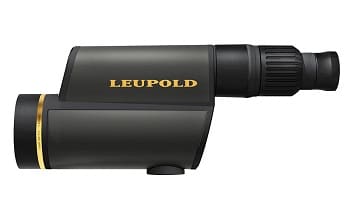
Leupold as a scope company is a legend among riflemen looking for a high-quality rifle scope. Their spotting scope line isn’t new but certainly doesn’t get the attention it deserves. Their line is split into three different categories and two different tiers.
The GR and Kenai are their premium spotting scopes, and their base model is the SX-1. Leupold offers a lot of different optics, magnifications, and overall sizes in these categories as well. Their extensive selection allows you to choose one that is tailored to your style of spotting.
Pros
They offer a clean and consistent picture at maximum magnification with their spotting scopes. Rarely does anything appear blurry or dim.
Spotting deer-sized objects out to a six or seven hundred yards is easy with most of the Kenai and GR models. The SX-1 falls a little behind here. You can see the object, but not clearly.
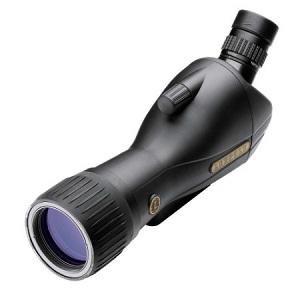
However, at its price, the SX-1 delivers a pretty clear picture and is consistent with other spotting scopes in its price range.
The Kenai is probably the best spotting scope for hunting in their line, and the GR is certainly better for the range. The SX-1 falls in between the two and can be purposed for a variety of tasks.
Cons
The downside to Leupold optics comes from their included tripod.
It’s usable, but it’s not excellent by any means. The tripod included in the kit doesn’t mesh with the high quality of the optics. It’s a little flimsy, and scuffs and scratches easily. The tilt bracket also feels all over the place when adjusting the scope.
Leupold also has a very close eye relief, which can be a minor inconvenience.
Nikon
Nikon is the Walmart of optics companies. They produce and sell everything optic related, from camera lenses to spotting scopes.
Their spotting scopes are divided into vastly different lines, and they offer scopes for roughly $350 all the way up to $6,000. In between, you have a little of everything. Nikon spotting scopes are a get what you pay for the deal.
Pros
The cheaper Pro Staff models will get the job done and will allow you to see easily out to around 500 yards decently.
What you’ll notice on some of the lower priced models is the disruptions around the periphery of the view field. This lowers your effective field of view.
However, what is in the center is often crystal clear. As you work your way into the more expensive models, this disappears and you’re left with a clear picture consistently.
Among all Nikon scopes, the image stays clear in the center of the scope, regardless of the magnification. They also tend to be clear of chromatic aberration, at least in the center of the scope.
Most models allow you to change the eyepiece quickly and come with excellent tripods.
Cons
- They are all almost smooth and textureless which make handling them a challenge when wearing tactical gloves or with wet or cold hands.
- They are not protected from impact. I’d be afraid of breaking one of these when hiking long distances.
Getting Spotted
Spotting scopes are some of the most misunderstood optics, and navigating the different options, features, and of course, brands can be confusing. Hopefully our guide can answer most of your questions.
They aren’t as complicated as they seem. It’s as simple as understanding a few specific terms and identifying your unique needs for a spotting scope. From there explore your options, try out a few, and make an informed decision.

